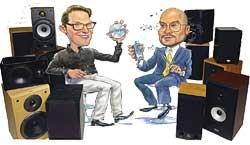Battle of The Bookshelfs

Why? Because in any comparative listening test there are going to be winners and losers. The trick is to make the test fair. Our comparison method sought both to eliminate the effects of listener preconceptions and bias and to help each speaker sound as good as possible. To do this we took several steps:
Physical setup. We arranged the speakers in each comparison group of three stereo pairs as close to each other as possible so the listener only had to turn his head slightly to bring the sonic image of each pair into focus. We equalized their heights by raising and lowering the stands so the height of the stereo image didn't change.
Level steup. We matched the speakers' levels within better than half a decibel using a test signal, a sound-level meter, and the level-trim controls on our switching panel. This step was extremely important because any larger deviation would have biased the comparisons in favor of the loudest speakers in each group. The master volume control was set at levels appropriate for each track we played.
Switching setup. To make the differences in sound quality as vivid as possible, each listener was able to switch between speaker pairs instantaneously while music was playing. The ear quickly forgets tonal contrasts and adapts to new tonal colorations, so rapid switching is necessary for critical comparisons.
Listening setup. The two experienced listeners - yours truly and my colleague Al Griffin, S&V's senior reviews editor - were literally kept in the dark as to which speakers we were hearing at any time. All six speaker pairs were hidden from us behind an acoustically transparent curtain of black grille cloth stretched across the lis ten ing room, and the room was darkened so the speakers were invisible. (Just try to get away with this at your local audio dealer!)
Hiding the speakers eliminated any effect that knowledge of which model we were hearing might have had on our sonic judgment. It also removed aspects of appearance, such as enclosure size and sty ling, from consideration. This was strictly a listening test - and a double-blind one at that, since it was S&V executive editor Brian Fenton who hooked up the speakers to the switching panel. Neither Al nor I knew which trio was being compared in our two sets of initial trials (which we conducted separately from each other). After all six speakers had been compared, we each held a "bakeoff" between the winners in the three-way comparisons.
Throughout the comparisons, each model was referred to only by the color of the switcher button, and only Brian knew which button was con nected to which pair of speakers. We even wrote up our results without knowing which was which, and the brands and models were inserted into this text at a later point - again, to avoid any brand-related bias.
Think we went too far? Were too scientific? Not warm and fuzzy enough? I'll let Al's comment on the procedure answer those reservations:
"At first, I didn't feel that such rigorous, double-blind testing conditions were necessary to evaluate speakers. But once the testing got underway, I found the lack of crutches - brand recognition, personal history and bias, visual preferences - liberating because it forced me to rely solely on my ears. Being able to switch instan taneously between speakers was also beneficial. Without rapid switching, flaws in the speaker tend to get smoothed out over time as your ears adjust. With rapid switching, sonic differences are much more easily grasped."
Why Small Bookshelfs? We asked each company to send its best "bookshelf" speaker priced around $300 a pair. We chose that target not only because it's a very popular price range, but also because it tends to be the lowest price at which speakers can supply reasonably full-range sound without a subwoofer. Not that a subwoofer wouldn't help: all six speakers in our comparison roll off steeply in the bottom octave (20 to 40 Hz), so none of them can reproduce the full, body-punching impact of an action-movie explosion or an orchestral bass drum. You shouldn't expect them to, either, though both Al and I tried them with this kind of material.
The speakers here are so similar in size, driver complement, and enclosure design (see "Fast Facts" below) because their mak ers are caught between the rock of the laws of physics and the hard place of manufacturing costs. Specify a price range for speakers, and you're likely to get very similar engineering solutions, especially at lower prices, where there's not much room for the designer to wiggle. It's the mostly subtle or invisible details - like the type and quality of the drivers, the crossover design, the spacing of the drivers, and the size, shape, and location of ports - that make these similar-looking speakers sound so very different from each other.
- Log in or register to post comments




















































